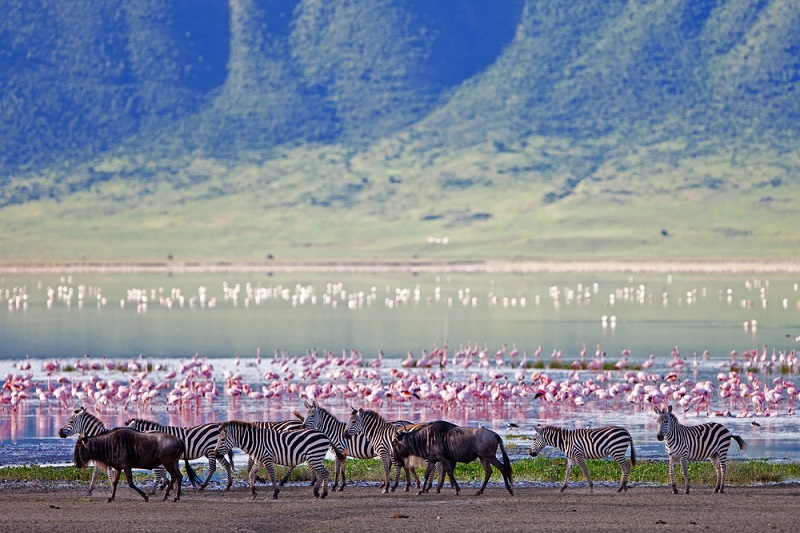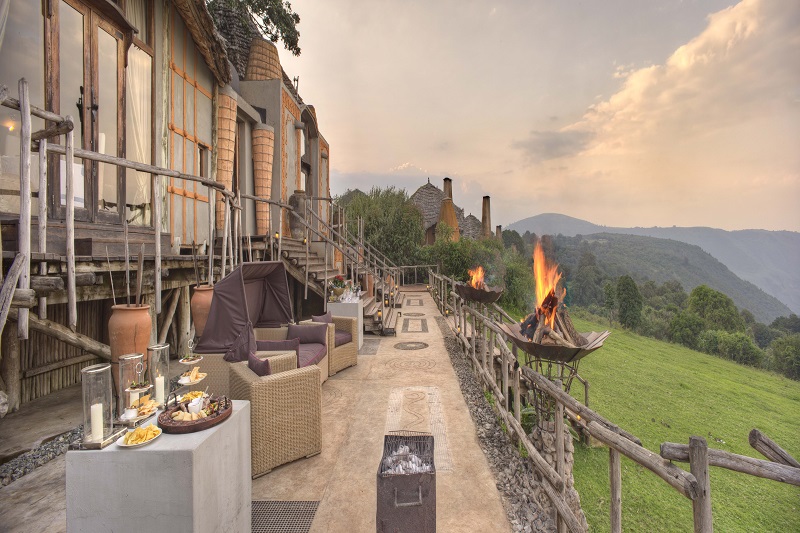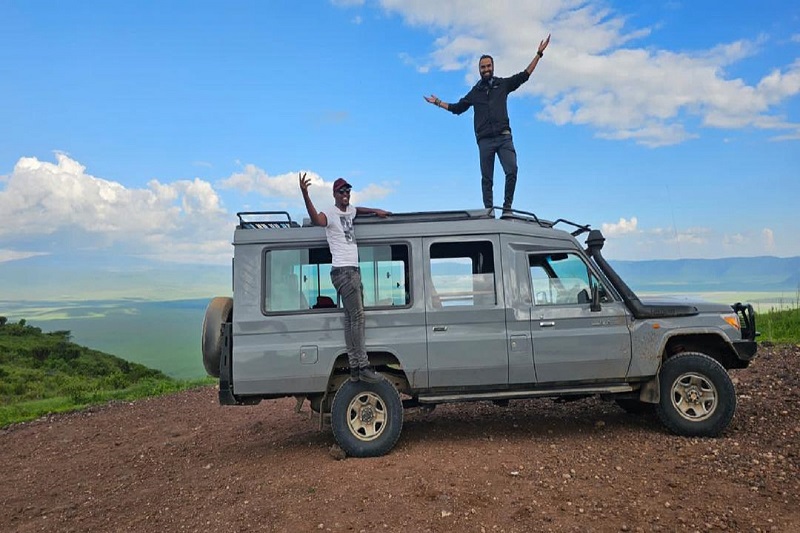A glimpse of what you will experience when visiting the Ngorongoro Crater, Explore with us!
The journey begins with the anticipation of visiting the Ngorongoro Crater, a world-renowned wonder and a UNESCO World Heritage Site. This breathtakingly beautiful area, often referred to as ‘Africa’s Garden of Eden’, was created two to three million years ago when a large volcano exploded and collapsed into itself.
Embark on a journey with us and discover the unparalleled beauty and allure of Ngorongoro, where every moment is an opportunity for discovery and inspiration.

Arrival
The Journey Begins: The journey to the Ngorongoro Crater starts early in the morning. As you leave the hustle and bustle of the city behind, you are greeted by the vast, open landscapes of Tanzania. The anticipation builds as you travel through the diverse landscapes.
First Glimpse: After a few hours of travel, you get your first glimpse of the crater. The sight is breathtaking - a vast expanse of blue and green, with the crater’s rim piercing the sky. The sheer size of the crater becomes apparent, and you can’t help but feel a sense of awe.
Climbing the Rim: The vehicle starts its climb up the crater rim. The vegetation changes as you ascend, with dense forest giving way to bushland. The air becomes cooler, and you can see clouds hanging low in the sky.
Arrival at the Rim: Upon reaching the rim, you are greeted by a spectacular view. The crater stretches out below, a tapestry of different habitats - grassland, swamps, and patches of acacia forest. The lake in the center of the crater glistens under the sunlight.
Descent into the Crater: The descent into the crater is an adventure in itself. The road is steep and winding, and with each turn, a new vista opens up. You can start seeing herds of wildebeest and zebra grazing on the crater floor.
Arrival at the Crater Floor: Finally, you arrive at the crater floor. The wildlife is abundant here - you can see herds of buffalo, prides of lion, and even a rhino if you’re lucky. The realization hits you - you are in one of the most unique wildlife destinations in the world.
Exploration
As you step out of your vehicle, you’re immediately struck by the vastness of the crater. The air is fresh, and the sounds of nature surround you. You can’t wait to start exploring this unique ecosystem.
-
Venturing into the Grasslands: Your first stop is the open grasslands. Here, you see herds of wildebeest and zebra grazing peacefully. You’re amazed by the sheer number of animals that call the crater home.
-
Visiting the Swamps: Next, you head towards the swamps. This area is teeming with birdlife. You spot flamingos, pelicans, and even a rare black rhino in the distance.
-
Exploring the Acacia Forest: You then venture into the acacia forest. The tall trees provide a stark contrast to the open grasslands. You spot a family of elephants, their large bodies partially hidden by the thick foliage.
-
Discovering Lake Makat: Your exploration leads you to Lake Makat, a soda lake in the center of the crater. The lake is a hub of activity, with hippos wallowing in the water and birds swooping down to catch fish.
-
Observing Predators: As the day progresses, you get the chance to observe the crater’s predators. You see a pride of lions lounging in the sun, and a hyena prowling in the distance.
-
Ending the Day: As the sun begins to set, you end your exploration. You’re left with a sense of awe at the diversity and abundance of life in the crater.
Wildlife Encounter
The Ngorongoro Crater is a wildlife paradise, home to over 30,000 animals1. As you begin your exploration, you’re immediately struck by the diversity and abundance of life in the crater.
The Grazers: The open grasslands are teeming with herds of wildebeest, zebra, and buffalo1. These grazers are the lifeblood of the crater’s ecosystem, providing food for a variety of predators.
The Predators: The crater is home to the world’s densest lion population. You see a pride of lions lounging in the sun, their golden coats blending with the tall grass. Spotted hyenas are equally common, and their cackling laughter echoes across the plains.
The Smaller Carnivores: Look out for smaller carnivores, such as golden and black-backed jackals and bat-eared foxes1. These creatures are often overlooked, but they play a crucial role in the ecosystem.
The Giants: Many lone bull elephants, carrying massive tusks, have made the crater floor their home1. Their majestic presence adds a sense of grandeur to the landscape.
The Rare Sightings: The Ngorongoro Crater is one of the best places in East Africa to look for the black rhino, an endangered species with a very restricted presence in Tanzania. Spotting one of these elusive creatures is a highlight of any visit.
Bird life: The crater is also a haven for birdwatchers, with hundreds of species calling it home. From the vibrant flamingos at Lake Makat to the pelicans in the swamps, the bird life is as diverse as the landscape itself.
Predator Sighting
The Crater is home to the highest number of predators found anywhere in Africa. Black-maned lions stalk the grasslands and display a complete indifference to the game vehicles. They compete for food with hundreds of hyenas as well as cheetah and jackals.
The Lions: The Ngorongoro Crater is home to the world’s highest density of lions. As you traverse the grasslands, you spot a pride of lions lounging in the sun. Their golden coats blend with the tall grass, and their regal demeanor is captivating. These lions live at a higher density than almost any others on the planet.
The Hyenas: Spotted hyenas outnumber lions on the Crater floor by six to one. These are the most commonly sighted predators, sometimes alone, just as often in clans ready to go to war. You observe a clan of hyenas, their cackling laughter echoing across the plains. Interestingly, in Ngorongoro, lions are far more likely to scavenge meals from hyenas than the other way around.
The Jackals: The black-backed or silver-backed jackal is often seen shadowing larger predators. These lean creatures are watchful and commonly sighted in Ngorongoro. But the golden jackal, its wolf-like counterpart, is far more elusive and a much-greater Ngorongoro prize.
The Rare Sightings:Spotting a black rhino, an endangered species with a very restricted presence in Tanzania, is a highlight of any visit. Your heart races as you spot one of these elusive creatures near the fringes of the Lereal Forest.
Departure
As the day ends, visitors leave the crater floor, carrying with them the unforgettable memories of this astonishing landscape and the wildlife encounters.
The Final Moments: As the sun begins to set, you take one last look at the Ngorongoro Crater. The golden light bathes the landscape, casting long shadows and highlighting the contours of the crater.
Reflection:You reflect on the day’s adventures - the wildlife sightings, the diverse landscapes, and the sheer beauty of the crater. You feel a sense of awe and gratitude for having experienced this unique ecosystem.
Leaving the Crater Floor:You board your vehicle and begin the ascent up the crater rim. The journey is slow and steady, giving you plenty of time to soak in the views one last time.
Climbing the Rim:As you climb the rim, you look back at the crater floor. From this height, the animals appear as tiny specks against the vast expanse of the crater.
Reaching the Top:Upon reaching the top, you stop for a moment to take in the panoramic view. The crater stretches out below you, a testament to the power of nature and the diversity of life.
The Journey Back: The journey back to your accommodation is quiet. Everyone is lost in their thoughts, replaying the day’s events in their minds.
As you drift off to sleep that night, the images of the Ngorongoro Crater dance in your mind. You know that this is an experience you will carry with you for the rest of your life.
Frequently Asked Questions
© 2024 Marhaba Escape Safari. All Rights Reserved












